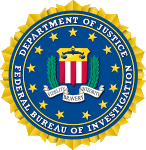- National Center for the Analysis of Violent Crime
-
Federal Bureau of Investigation Common name Federal Bureau of Investigation Abbreviation FBI Seal of the Federal Bureau of Investigation agency information Motto Fidelity, Bravery, Integrity Agency overview Formed July 26, 1908 Employees 35,437[1] (May 31, 2011) Annual budget 7.9 billion USD (2010)[1] Legal personality Governmental: Government agency Jurisdictional structure Federal agency
(Operations jurisdiction)United States Legal jurisdiction As per operations jurisdiction. Governing body United States Congress Constituting instrument United States Code Title 28 Part II Chapter 33 General nature - Federal law enforcement
- Civilian agency
Operational structure Headquarters J. Edgar Hoover Building, Washington, D.C. Sworn members 13,963 (May 31, 2011)[1] Unsworn members 21,474 (May 31, 2011)[1] Agency executives - Robert S. Mueller III, Director
- Timothy P. Murphy, Deputy Director
- List of FBI Directors, Other directors
Child agencies Major units 5- Behavioral Analysis Unit (BAU)
- Law Enforcement Bulletin Unit (LEBU)
- Hostage Rescue Team (FBI) (HRT)
- Joint Terrorism Task Force (JTTF)
- FBI Police
- National Security Branch (NSB)
Field offices 56 (List of FBI Field Offices) Notables People - John Edgar Hoover, Director, for being the founding director
- William Mark Felt, former Federal Agent, for whistle blowing, Watergate scandal
- Joseph Leo Gormley, Forensic Scientist, for expert testimony
Significant Operations Website fbi.gov
this informationIn November 1982, following a meeting between members of the Criminal Personality Research Project advisory board and other specialists, the concept of a single [2] (NCAVC) was put forward. This elite investigative branch was never envisaged as a replacement for traditional crime investigation by local law enforcement agencies. The proposal was unanimously adopted seven months later by a conference held at Sam Houston State University's Center for Criminal Justice in Huntsville, Texas. The delegates agreed that the NCAVC should be founded at the FBI Academy in Quantico and run by the agents of Behavioral Science Unit. President Ronald Reagan formally announced the establishment of NCAVC on 21 June 1984.
The NCAVC was conceived in 1981 by Robert K Ressler during a conversation with then Quantico director Jim McKenzie. Jim McKenzie ran with the idea and as stated in the previous paragraph eventually had it realised.
The mission of the NCAVC is to coordinate investigative and operational support functions, criminological research, and training in order to provide assistance to federal, state, local, and foreign law enforcement agencies investigating unusual or repetitive violent crimes (serial crimes). The NCAVC also provides investigative support through expertise and consultation in non-violent matters such as national security, corruption, and white-collar crime investigations. President Reagan gave it the primary mission of ‘identifying and tracking repeat killers,’ a term he used for serial killers.
The NCAVC uses the latest advances in computer and investigative strategies to combat serial and violent crime. ViCAP (Violent Criminal Apprehension Program) and PROFILER, (a robot, rule-based expert system programmed to profile serial criminals). CIAP (Criminal Investigative Analysis Programme) is another program designed to investigate serial crime.
VICAP specifically works by identifying and linking the signature aspects in violent serial crimes. The signature of a crime is the intrinsic part of the crime which the criminal must include in order for him to be satisfied (as Ted Bundy would say what the killer must do to "Get his rocks off")and thus is present in every crime committed by the same person (although the signature does evolve over time).
Today, every division in the FBI is mandated to have an NCAVC coordinator also known as a profiling coordinator. The NCAVC or profiling coordinator acts as a liaison to the local law enforcement agencies. Typical cases for which NCAVC services are requested include child abduction or mysterious disappearance of children, serial murders, single homicides, serial rapes, extortions, threats, kidnappings, product tampering, arsons and bombings, weapons of mass destruction, public corruption, and domestic and international terrorism. The operational services of the NCAVC are supported by research and training programs. Requests for NCAVC services are typically facilitated through NCAVC coordinators assigned to each FBI field office.
The NCAVC is further organized into three components:
- Behavioral Analysis Unit (BAU)- East/West Regions;
- Child Abduction Serial Murder Investigative Resources Center (CASMIRC);
- Violent Criminal Apprehension Program (VICAP).
References
- ^ a b c d "Quick Facts". Federal Bureau of Investigation. http://www.fbi.gov/quickfacts.htm. Retrieved 2009-11-20.
- ^ National Center for the Analysis of Violent Crime http://www.fbi.gov/about-us/cirg/investigations-and-operations-support
See also
- Modus operandi
- Signature crime
Categories:- Federal Bureau of Investigation
- Criminal investigation
- Criminology organizations
- Government agencies established in 1984
Wikimedia Foundation. 2010.

